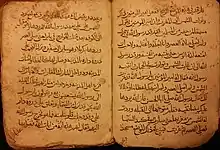Abu ʿAbd-Allāh al-Ḥusayn ibn Ḥamdān al-Jonbalānī al-Khaṣībī الحسين بن حمدان الخصيبي | |
|---|---|
| Personal | |
| Died | 969[1] |
| Religion | Islam |
| School | Shia |
| Sect | Alawite |
| Senior posting | |
| Teacher | Ibn Nusayr |
| Successor | Muhammad ibn Ali al-Jilli[2] |
| Initiated |
|
| Part of a series on Shia Islam |
|---|
 |
|
|
Abu ʿAbd-Allāh al-Ḥusayn ibn Ḥamdān al-Jonbalānī al-Khaṣībī[2] (Arabic: الحسين بن حمدان الخصيبي), died 969,[1] was originally from a village called Jonbalā, between Kufa and Wasit in Iraq, which was the center of the Qarmatians.[3] He was a member of a well-educated family with close ties to eleventh Twelver Imam Hasan al‐Askari and a scholar of the Islamic sect known as the Alawites or Nusayris, which is now present in Syria, southern Turkey and northern Lebanon.

For a time, al-Khaṣībī was imprisoned in Baghdad, due to accusations of being a Qarmatian. According to the Alawites, after settling in Aleppo, under the rule of the Shia Hamdanid dynasty, he gained the support and aid of its ruler, Sayf al-Dawla, in spreading his teachings. He later dedicated his book Kitab al‐Hidaya al‐Kubra to his patron. He died in Aleppo and his tomb, which became a shrine, is inscribed with the name Shaykh Yabraq.[4]
He taught several unique beliefs, including that Jesus was every one of the prophets from Adam to Muhammad as well as other figures such as Socrates, Plato and some ancestors of Muhammad, and that other historical figures were the incarnations of Ali and Salman al-Farisi.[5]
He and his works were praised by the Iranian Shiʿite scholar Muhammad Baqir Majlisi.[6]
Exposure to Nusayri doctrine
Al-Khasibi's first exposure to the teachings of Ibn Nusayr was through ʿAbdallāh al-Jannān, who was a student of Muḥammad ibn Jundab, who was a student of Nusayr himself. Having been initiated into the doctrine through al-Jannān, Khasibi was now al-Jannān's "spiritual son". With the death of al-Jannān, however, al-Khasibi had no means of continuing practice and study of the doctrine. This period of dryness ended later when he encountered an ʿAlī ibn Aḥmad, who claimed to be a direct disciple of Nusayr.
In this manner, al-Khasibi received transmission from both al-Jannān and ʿAlī ibn Aḥmad, thus continuing transmission of the Nusayri doctrine. Khasibi did not necessarily believe he was representative of a splinter, rebel group of the Shias, but rather believed he held the true doctrine of the Shias.[7]
During his reign, the founder of the Alawite sect, al-Khasibi, benefited from Sayf al-Dawla's patronage. Al-Khasibi turned Aleppo into the stable centre of his new sect, and sent preachers from there as far as Persia and Egypt with his teachings. His main theological work, Kitab al-Hidaya al-Kubra, was dedicated to his Hamdanid patron. Sayf al-Dawla's active promotion of Shi'ism began a process whereby Syria came to host a large Shi'a population by the 12th century.
See also
| Part of a series on Shia Islam |
| Twelver Shi'ism |
|---|
|
|
References
- 1 2 Friedman 2008–2012; Friedman 2016. The Encyclopædia Britannica cites 957 or 968 as two possible dates for his death.
- 1 2 3 Friedman 2008–2012.
- ↑ Hanna Batatu (17 Sep 2012). Syria's Peasantry, the Descendants of Its Lesser Rural Notables, and Their Politics. Princeton University Press. p. 18. ISBN 9781400845842.
- ↑ Matti Moosa (1987). Extremist Shiites: The Ghulat Sects. Syracuse University Press. pp. 264, 266. ISBN 9780815624110.
- ↑ Matti Moosa (1987). Extremist Shiites: The Ghulat Sects. Syracuse University Press. pp. 263–4. ISBN 9780815624110.
- ↑ Friedman, Yaron (2010). The Nuṣayrī-ʿAlawīs: An Introduction to the Religion, History and Identity of the Leading Minority in Syria. Leiden: Brill. p. 26. ISBN 9789004178922.
- ↑ Friedman, Yaron (2010). The Nuṣayrī-ʿAlawīs: An Introduction to the Religion, History and Identity of the Leading Minority in Syria. Leiden: Brill. pp. 17–20. ISBN 9789004178922.
Further reading
- Friedman, Yaron (2008–2012). "Ḵaṣibi". In Yarshater, Ehsan (ed.). Encyclopædia Iranica.
- Friedman, Yaron (2016). "al-Khaṣībī, Abū ʿAbdallāh". In Fleet, Kate; Krämer, Gudrun; Matringe, Denis; Nawas, John; Rowson, Everett (eds.). Encyclopaedia of Islam, Three. doi:10.1163/1573-3912_ei3_COM_30574.